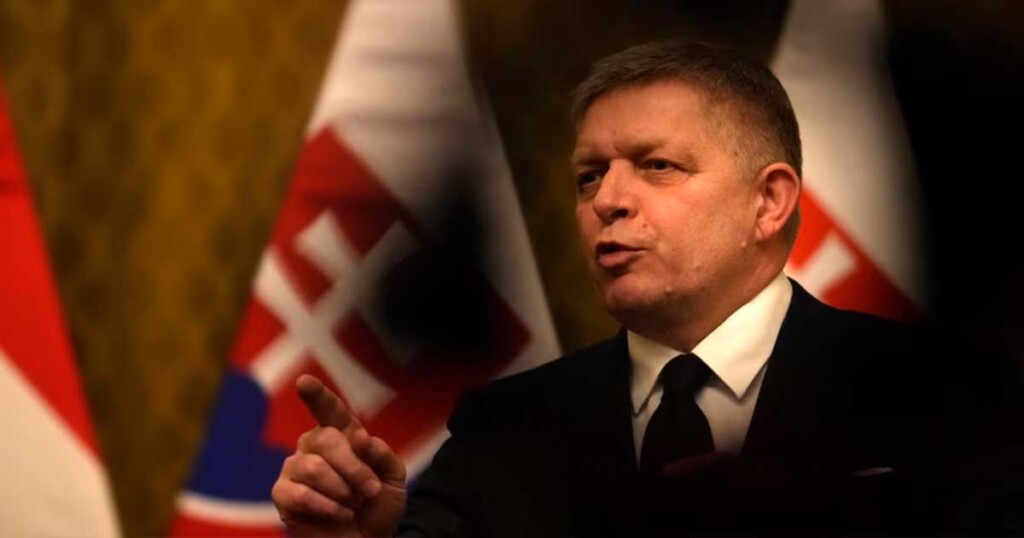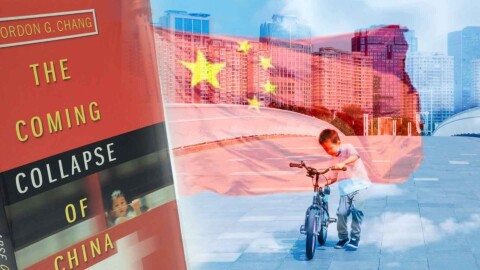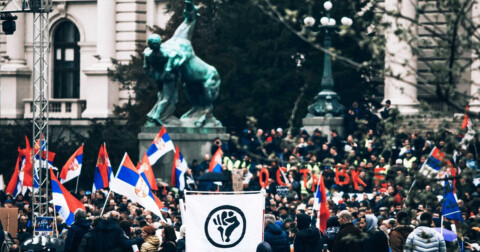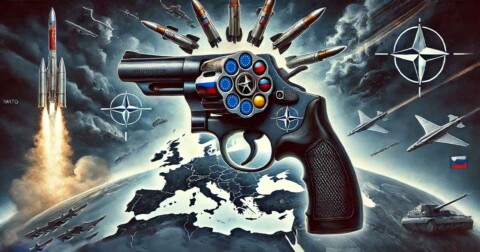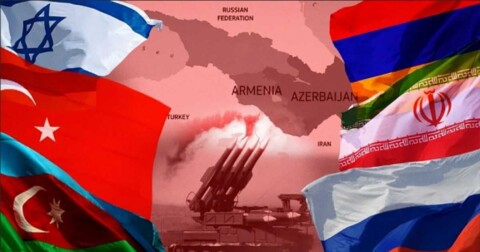Since the Velvet Revolution of 1989, which was initiated by students, leading to the fall of communist rule and later the country’s independence, Slovakia has not had a more significant political figure than Robert Fico. However, overnight, the Slovak Prime Minister has been declared the greatest “enemy” of his own country. To understand why the protests in Slovakia are part of broader geopolitical upheavals, it is important to take a look at his political career.
FOURTH TERM AND ASSASSINATION ATTEMPT
Robert Fico, leader of the social-democratic Smer party, has been Slovakia’s longest-serving prime minister in history, holding office for three terms (2006–2010, 2012–2018). As early as 2008, he opposed the independence of the so-called Kosovo, which Slovakia still does not recognize. During his first term, he strengthened Slovak-Russian relations, referring to “Slavic solidarity,” a central theme of Slovak national awakening since the 19th century. In the 2012 elections, he won an absolute majority, the first since 1989. During his second term, he criticized the 2013 Euromaidan and the EU’s interference in Ukraine’s internal affairs. When the conflict in Ukraine broke out in 2022, even though he was out of power, he opposed sanctions against Russia.
In October 2023, Fico won 22.95% of the vote, making Smer the largest party in Slovakia. He advocated sovereignist and protectionist policies: opposing gender ideology, same-sex marriage, and illegal immigration. After stating that “Ukraine is not independent” and that the conflict must be resolved peacefully, he survived an assassination attempt on May 15, 2024, carried out by Juraj Cintula. Fico recovered from serious injuries, while the attacker claimed to be motivated by Fico’s anti-EU policies and opposition to military aid to Ukraine.
INDEPENDENCE FROM BRUSSELS DICTATORSHIP
In October 2024, Robert Fico visited China, where, like Viktor Orbán, he criticized Western sanctions against Russia and support for Ukraine. He emphasized that Slovakia must pursue a sovereign policy, independent of the “Brussels dictatorship.” The visit had an economic character, as the government relies on Chinese investments to revitalize the economy. Fico seeks cooperation with China on infrastructure reconstruction and opposes European tariffs on Chinese vehicles, according to “China News.” This course represents a pragmatic response to economic and political realities, as well as the crises that have affected Slovakia over the past three years, constituting a policy of long-term action.
During the 2023 campaign, Fico opposed military aid to Kyiv, stating that he would not send “a single bullet” to Ukraine in order to prevent the escalation of violence. The public, who have found themselves in an increasingly difficult economic position due to the energy crisis and inflation caused by European sanctions against Russia, welcomed his stance.
ANTI-WAR POLICY
A GLOBSEC survey revealed that half of Slovaks see the United States as a threat to Slovakia, an increase from 39% in 2022. Not only that, but Fico won the election precisely due to his anti-war policy, promising to block Ukraine’s entry into NATO. He considered Ukraine’s EU accession “unrealistic.” Thus, Fico distinguished himself as a true advocate of national interests and the people’s will, which is essentially anti-war, peaceful, and sovereignist.
On Friday, January 24, 2025, tens of thousands of Slovaks protested against the policies of Prime Minister Robert Fico, whom, just over a year ago, they had elected in a legitimate democratic process. How did this turnaround happen? Where did such a dramatic shift in voter perception come from? It seems that no one is for peace anymore, and everyone is for war.
The organization “Peace for Ukraine,” led by Lucia Štaselová, has been the main driver of these protests, alongside several other groups that we will return to later.
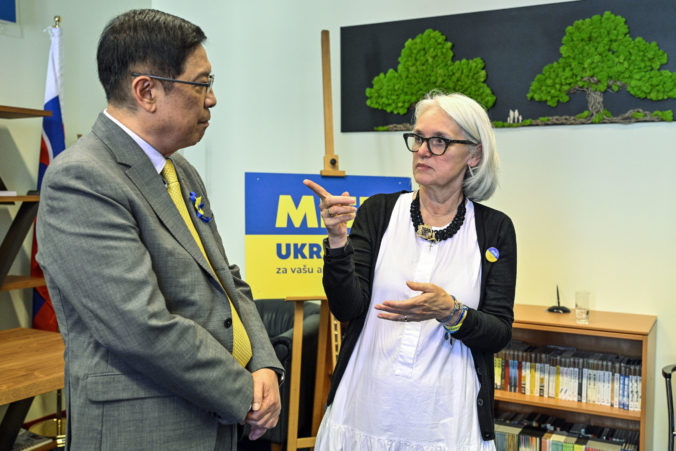
UNUSUAL MOMENTUM
The demonstrations were allegedly sparked by Fico’s visit to Moscow in late 2024, where he met with Putin to discuss the transit of Russian gas through Ukraine, which was halted on January 1, 2025. Although the meeting was economic in nature, some citizens perceived it as an act of betrayal, which supposedly triggered the protests. However, there are several inconsistencies in this narrative that deserve attention.
The first protests after Fico’s meeting with Putin were immediate but insignificantly small. However, by January 24, they had grown into massive and well-organized demonstrations. In other words, the initial spontaneous protests on December 23 attracted only a small number of people, creating the impression of a genuine reaction from a truly dissatisfied part of the population. Then, after a period of calm, large and well-organized rallies erupted across the country.
By January 3, the protests had gathered 4,000 people, by January 10, that number had grown to 15,000, and by January 24, there were as many as 100,000 across Slovakia, with most of them in Bratislava (symbolically on Freedom Square). The largest protests took place on February 7 in 41 locations, with demonstrations also supported in foreign cities such as Prague, London, and Paris.
PLAYING ON THE ANTI-COMMUNIST SENTIMENT
The main criticism against Fico is his shift in foreign policy. Demonstrators in Bratislava chanted slogans like “Slovakia is not Russia,” “Treason,” and “Resignation.” The protests brought together a broad spectrum of citizens, including pro-Western students, actors and activists, veterans of the 1989 anti-communist movement, and a significant number of Ukrainian refugees—an interesting selection. Additionally, it is worth noting that the same groups protesting against Fico conveniently ignore major political contradictions within the Western bloc itself.
This was followed by slogans emphasizing the struggle for justice, democracy, and Slovakia’s European future. Such demonstrations do not exclude the factor of foreign influence. Many protest participants, as reported by “DW,” claim to be fighting for democratic and anti-communist values allegedly represented by the current prime minister. The message is skillfully adapted to the anti-communist sentiment of a Central European state, a former member of the Eastern Bloc. Soon, the protesters were portrayed as “the voice of the people,” while the government was labeled as repressive. A painfully familiar scenario. Brussels, just like in the case of NIS in Serbia, began applying economic pressure to stir up tensions and weaken the prime minister’s position. Fico was even accused of Nazism, with slogans linking him to Jozef Tiso and “collaborators.” Here, several contradictions arise.
PREPARATION FOR A COUP
Fico’s views on Russia indeed differ from mainstream European politics, but this should not be equated with democracy and its values. Russia is neither a Nazi nor a communist country, and Fico is neither. Furthermore, as previously mentioned, he has been working on strengthening Slovak-Russian ties since his earlier mandates, meaning this is not a hasty policy shift. His condemnation of Euromaidan and EU interference in Ukrainian affairs dates back to 2013, as a logical continuation of Slovakia’s existing foreign policy. The Slovak population has supported this policy for nearly two decades. Additionally, the EU often dictates foreign policy to its member states, making it seem that Fico is the one upholding democratic principles—sovereignty and the right of the majority to determine the country’s foreign policy, just as the people did in the 2023 elections. Instead of evaluating the effects of sanctions and interventions, the protests focus on Fico’s personal views, which only highlights the political immaturity of those on the streets.
Fico accused the organizers and opposition of being in contact with foreign actors working on designing a coup in Slovakia, linking these claims to reports from the Slovak Intelligence Service (SIS).
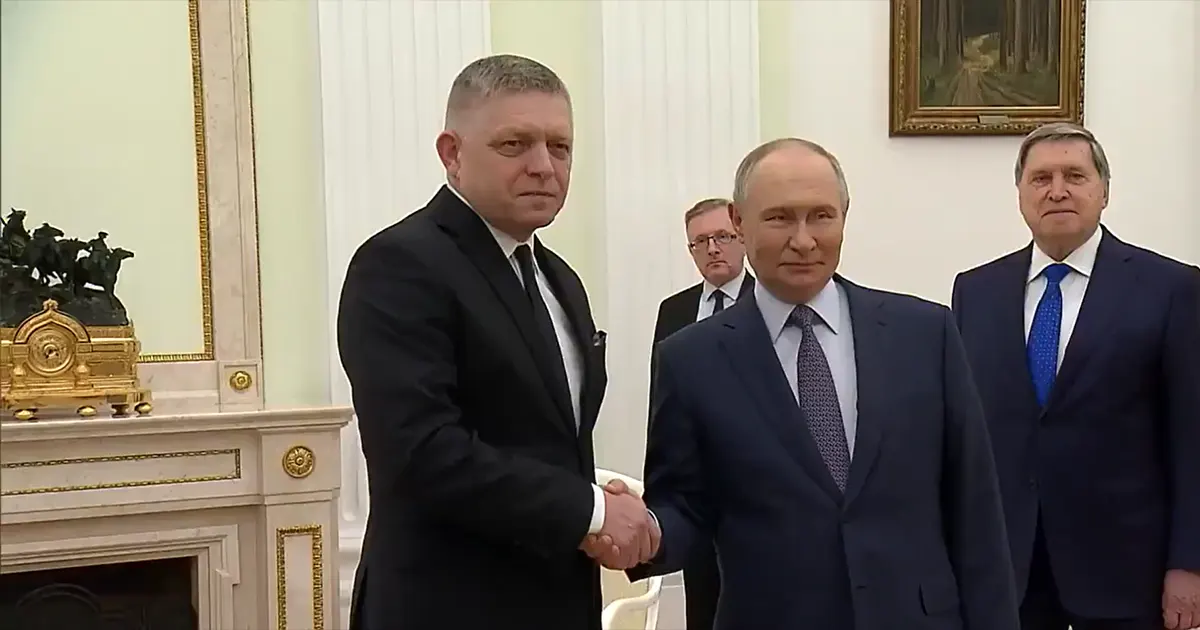
INNOCENT CITIZENS AND ONE MASTER BEHIND THE SCENES
The prime minister claimed that the opposition was planning to occupy government buildings, block roads, organize strikes, and provoke clashes with the police—similar to events in Serbia. He also stated that intelligence services have evidence of foreign interference in the protests in Georgia and Ukraine in 2013, which is now becoming visible in Slovakia. Protesters accused Fico of undermining state institutions and Slovakia’s position within the EU and NATO. Although he denied claims that he wanted to withdraw Slovakia from these organizations, the protests continued, and the organization Peace for Ukraine began attacking the government for “lies and destabilization.”
The demonstrators deny the prime minister’s claims. Štaselová stated that the protests were not organized by foreign actors, “but rather that genuine local citizens are expressing dissatisfaction.” However, in this case, as in Serbia, the question is not so much about who is dissatisfied, but rather who will benefit from the protests and gain access to power. This issue is not only about what the people want, but also about who is leading them, who controls the demonstrations, and who gains political leverage. In response to Fico’s accusations, Marian Kulič stated that these were the same methods used by “Erdogan in Turkey, Orbán in Hungary, Irakli Kobakhidze in Georgia, and Vučić in Serbia,” adding that “they all use the same narrative.”
THE ROLE OF FOREIGN INSTRUCTORS
The opposition and protesters accuse Fico of paranoia, claiming that he is “spreading hatred and fear.” This raises an important question: is this truly paranoia, or is it a strategy to create a sense of external threat and unite people against a common enemy?
Student Simon Omanik believes that young people are “intimidated” and encourages them to “stand up for their opinions and not be afraid to defend them.” Skepticism and distrust in state institutions are widespread, not only in Slovakia but globally. In the 21st century, people increasingly question government institutions, and the need for transparent dialogue has never been greater, fostering deep mistrust among populations. This is, therefore, a common modern trend.
Fico stated that the cyberattack that hit the country on January 24 was a textbook example of “how to dismantle a disobedient government with unorthodox views on certain issues”—referring to his opposition to arming Ukraine and his efforts to improve relations with Moscow. He claimed that the attack was carried out by opposition representatives, NGOs, foreign instructors, and media outlets. He also announced that the police would deport some foreign “instructors,” including Ukrainians who were assisting the opposition in attempting to overthrow his government.
ZELENSKY AND MADONNA
Something similar happened in Serbia when the state identified Croatian students suspected of being involved in organizing blockades. Although Slovak officials believe the attack could have come from Ukraine, Kyiv denied those claims. The opposition rejected the report, accusing the SIS of political misuse, just as demonstrators in Serbia mocked government responses, seeing them as an abuse of power. The organizers of the Peace for Ukraine rallies dismissed Fico’s claims, stating that he was trying to intimidate the population. The parallels with Serbia are once again evident.
Volodymyr Zelensky supported the anti-government protests in Slovakia, emphasizing that Slovakia is part of Europe. On X, he stated: “Bratislava is not Moscow. Slovakia is Europe.” Western media, including those from Washington, London, and Prague, backed the demonstrators, insisting on the authoritarianism of the prime minister and attempting to pull Slovakia firmly into the Western bloc, indicating that the protest is not merely the result of dissatisfaction but part of a broader political strategy. The similarity to Madonna’s support for Serbian students is undeniable—using media influence to promote certain ideas or interests.
On the other hand, Alexander Lukashenko stated that the protests in Slovakia and Serbia were “coordinated from abroad,” primarily by the United States, adding that the Slovak people would soon realize who was manipulating them.
ŠTASELOVÁ: FOLLOW SERBIA’S EXAMPLE
In a calculated statement in January, Fico did not address the pro-Western and pro-liberal students or dissatisfied citizens but rather the foreigners whom he believes are working to overthrow him, including the French, Americans, and NGOs pushing Slovakia into war against Russia. As previously mentioned, the main organizer of these protests is the Peace for Ukraine organization. However, the name of this organization does not align with its goals, which are directed against a government that opposes sending weapons to Ukraine, advocates for a peaceful resolution of the conflict, and even offers its country as a host for a peace agreement. Lucia Štaselová, a leading member of the organization, supports military aid to Ukraine. The organization, founded in Prague in 2020 and expanded to Slovakia in 2021, has been focused on supporting the Kyiv regime since the war began. Štaselová also supported the protests in Serbia, using them as an example for Slovaks. She stated that the Serbian protests were a true “fight for democracy and justice,” an example of a successful “popular revolt,” in a country that “is not Western,” but where, after weeks of protests “against corruption that is destroying Serbia… the pro-Russian prime minister’s government fell.”
There are also other important NGOs closely connected to globalist networks. The For a Decent Slovakia movement is funded by George Soros’s Open Society Foundation, while the Progressive Slovakia party is backed by Western think tanks. Activists coordinate protests through Telegram channels that were used in previous regime-change scenarios, confirmed by Elena Fritz, a member of AfD.
REFLECTION OF GLOBAL TENSIONS
Geopolitics explains politics, and without considering the geopolitical context, political and social crises remain insufficiently understood. Slovakia stands at a crossroads between Western alliances and sovereign cooperation with the East, a crucial fact for a deeper understanding of the protests. As the government in Bratislava distances itself from NATO’s and the EU’s aggressive policies, the protest atmosphere intensifies. The protests, therefore, are not merely a reflection of local discontent but also of broader global tensions.
There is likely a reason why Robert Fico compared the situation in Slovakia to that in Serbia, as well as to the crises in Romania and Georgia. While there are genuinely dissatisfied people, someone is coordinating the protests with the aim of influencing the geopolitical and political course of these countries. NATO’s strategy envisions that everything west of the Baltic Sea – Black Sea – Anatolia line must be under Western control. This manifests in the push for a centralized European system, with Brussels as a pseudo-center of power. In this envisioned NATO dictatorship—should it come to pass—there will be no room for visits to Moscow, for rejecting sanctions on Russia, for conducting even a semi-sovereign and semi-independent policy, for opposing Western war-mongering plans, for energy cooperation with Russia, or for cultural and intellectual ties with the East.

SPECIFICITIES OF SERBIAN PROTESTS
If we can recognize color revolutions in foreign countries, then we must be rational and clear-headed enough to understand that protests in Serbia are not merely a pure expression of public dissatisfaction either. Perhaps in Georgia and Slovakia, the developments can be reduced to a simple choice—either you support the West, or you oppose it. Serbia, however, is a different case. Protests in Serbia are not as direct as in Slovakia. In Serbia, things must be done more cunningly and subtly for several reasons. First, a significant portion of the population has held a strong anti-Western sentiment since NATO’s aggression in 1999. Second, the country was burned by the protests and revolution of 2000, which placed Serbia in a semi-colonial position—a burden that subsequent governments have carried. Third, the Serbian people simply lack enthusiasm for the EU. Fourth, there is a cultural factor tied to national interests, such as the Kosovo issue, Republika Srpska, and Serbia’s deep historical and cultural ties with Russia. Slovakia is a “simpler” country; it does not have such severe problems or a troubled past, making their protests more straightforward and open. Therefore, true leadership in their protests stems from the issue itself, which is not the case in Serbia.
Why do protests advocating for democratic values, freedoms, and fighting corruption not happen in other undemocratic and corrupt EU countries if this is truly a “great awakening of the people”? Countries like Bulgaria, Greece, and Croatia—EU members—face significant corruption but remain relatively calm. The protests in Greece following the Tempi railway disaster were short-lived, merely reflecting how the Serbian situation spills over into the entire region. A similar phenomenon occurred in Bosnia and Herzegovina, Montenegro, and Croatia, where students and citizens expressed solidarity with Serbian students. However, none of these movements have the same strength as those in Serbia. These examples indicate that the Balkans remain a powder keg that must be handled with caution.
LONG LIVE MARX, LONG LIVE NIETZSCHE, LONG LIVE DARWIN!
Let’s return to Slovakia. Although at first glance everything may seem like a minor or short-lived instability, the situation in this country is far from harmless and indicates deeper geopolitical and internal divergences that foreshadow a serious crisis. The crisis in the streets has spilled over into the government, much like in Serbia. Fico’s coalition, which started its mandate with a narrow majority (79 out of 150 MPs), lost its majority after four MPs withdrew, leading to parliamentary paralysis. Many analysts predict the possible collapse of Fico’s government by the end of January 2025 and calls for snap elections. In any case, three scenarios remain: Fico’s fall, successful resistance, or a compromise with the West.
However, what is symptomatic and identical in both Slovakia and Serbia is the almost openly anarchist, nihilistic, and fatalistic stance of the demonstrators, directly opposing the traditionally Christian foundation of both nations (more pronounced in Serbia). Let’s recall that the Christian concept envisions a state that is just, moral, and socially responsible, serving the common good and welfare. This stands in stark contrast to the situation on the ground. Andrej Matisak, editor of the Slovak daily Pravda, states that “it is unclear what exactly will happen” to the state and government.
DOES SERBIA HAVE ITS OWN ŠIMEČKA?
“Personally, I don’t believe the protest will change anything, but at least it will unite people to make a difference in the elections,” said Matej Debnar, one of the demonstrators at the rally in Bratislava. For many, it seems irrelevant what happens after the government falls—the only thing that matters is that it falls. This highlights an unconditional and chaotic desire for the government’s downfall, without a clear stance on who should take over or whether the future government will be more effective than the current one. One possible candidate to take power in Slovakia is Michal Šimečka, leader of the aforementioned social-liberal Progressive Slovakia party. This party advocates for neoliberal and progressive values, strongly pro-European and green policies. The trends clearly indicate increasing pressure from Europe for further integration and the acceptance of Western values in “insufficiently submissive states.”
The fact that Serbia has not yet produced its own Šimečka does not mean it won’t. It doesn’t matter what happened in December and January—what matters is who will win the final and most crucial battle: the students (who will most likely be deceived) or the new Serbian “progressive” and “neoliberal.”
AT A CROSSROADS OF DECISIONS
Although Slovakia has not seen the same level of protest radicalization as Serbia or Georgia, everything points to a deeper geopolitical context. Slovakia is not as crucial to NATO as Serbia, Romania, and Georgia, but its protest movements and potential political shifts could have serious implications for the country’s stability and its future in the geopolitical landscape.
While the protest movements in Slovakia may seem like a local phenomenon, they are, in reality, part of a broader wave affecting other countries in the region, where Western influence is increasingly being questioned. Like Serbia and Romania, Slovakia stands at a crossroads of major decisions that affect not only its internal political stability, corruption, and freedoms but also its relations with major powers. Often, such events determine the future of a nation and, in some cases, its very survival: the October Revolution of 1917, the Nazi rise to power in 1933, the March Coup of 1941, the Iranian Revolution of 1979, the Arab Spring of 2010, Maidan in 2014… The ruling elite, as well as the people of all these countries, have only weeks or months to position themselves in relation to these events. And ultimately, to choose the model they will live under in the coming years—if not decades.
